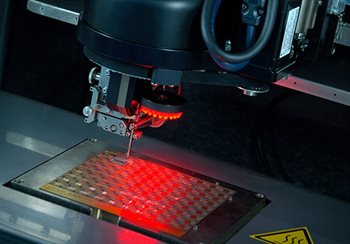Wire bonding is the process of creating electrical interconnections between semiconductors (or other integrated circuits) and silicon chips using bonding wires, which are fine wires made of materials such as gold and aluminium.
 The two most common processes are gold ball bonding and aluminium wedge bonding.
The two most common processes are gold ball bonding and aluminium wedge bonding.
Gold wire bonding is achieved through thermosonic bonding. This involves melting the end of the wire to form a gold ball, which is known as a free-air ball. The diameter of the free-air ball measures 1.5 to 2.5 times the diameter of the wire. After being formed, the free-air ball is placed into contact with the bond pad and pressure, heat and ultrasonic forces are applied to it for a certain amount of time. This forms a metallurgical weld between the ball and the bond pad while also allowing deformation of the ball bond into its ending shape.
In the next step, the wire is run to a finger of the lead frame, which forms an arc between the bond pad and the lead finger. A second bond, called a wedge bond, is then formed through applying pressure and ultrasonic forces to the wire using the lead finger. A machine called the wirebonder then clamps the wire and raises the capillary in order to break the wire to prepare for the next wirebonding.
Aluminium wedge wire bonding involves bringing a clamped aluminium wire in contact with the aluminium bond pad. The wire is then held down while ultrasonic energy is applied to it for a certain amount of time, which forms the first wedge bond between the wire and bond pad, before being pressed against the corresponding lead finger. Further application of ultrasonic energy to the wire forms the second bond, before the wire is broken off by being clamped and moved.
Compared to aluminium wedge bonding, gold ball bonding is significantly faster due to being non-directional, resulting in its widespread use in plastic packaging. However, gold ball bonding on aluminium bond pads cannot be used in hermetic packages due to the high sealing temperatures used in such packages, as these temperatures greatly accelerate the formation of gold-metal intermetallics which can result in early life failures. Conversely, gold ball bonding on gold bond pads can be utilised in hermetic packages.
Gold-aluminium ball bonding requires the use of heat to enable the bonding process. Good bonding between the aluminium bond pad and the gold ball bond - without causing damage to the wire, bond pad or silicon substrate - through solely ultrasonic methods is impossible due to the aluminium bond pad being harder than the gold ball bond. The aluminium bond pads are softened through applying thermal energy to them, which encourages the aluminium and gold atoms to inter-diffuse, which forms the gold-aluminium bond. The application of thermal energy also improves the bonding process by eliminating organic contaminants on the surface of the bond pad.
Recent transitioning in the wire bonding industry has seen a preference in copper over gold for use in the wire bonding process, the reason being that the cost of gold is rising. Despite there being concerns that copper is less reliable due to its hardness and susceptibility to corrosion, copper wire can be used at smaller diameters while performing identically to gold, making it more cost-effective.